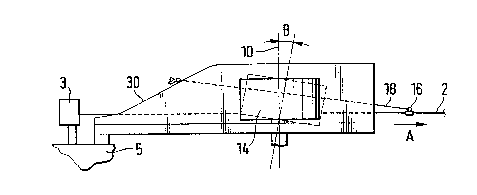Some of the information on this Web page has been provided by external sources. The Government of Canada is not responsible for the accuracy, reliability or currency of the information supplied by external sources. Users wishing to rely upon this information should consult directly with the source of the information. Content provided by external sources is not subject to official languages, privacy and accessibility requirements.
Any discrepancies in the text and image of the Claims and Abstract are due to differing posting times. Text of the Claims and Abstract are posted:
| (12) Patent Application: | (11) CA 2228406 |
|---|---|
| (54) English Title: | AN OUTHAUL DEVICE FOR FISHING LINES |
| (54) French Title: | DISPOSITIF DE HALE-DEHORS POUR LIGNES DE PECHE |
| Status: | Deemed Abandoned and Beyond the Period of Reinstatement - Pending Response to Notice of Disregarded Communication |
| (51) International Patent Classification (IPC): |
|
|---|---|
| (72) Inventors : |
|
| (73) Owners : |
|
| (71) Applicants : |
|
| (74) Agent: | LAVERY, DE BILLY, LLP |
| (74) Associate agent: | |
| (45) Issued: | |
| (86) PCT Filing Date: | 1997-06-02 |
| (87) Open to Public Inspection: | 1997-12-11 |
| Availability of licence: | N/A |
| Dedicated to the Public: | N/A |
| (25) Language of filing: | English |
| Patent Cooperation Treaty (PCT): | Yes |
|---|---|
| (86) PCT Filing Number: | PCT/NO1997/000139 |
| (87) International Publication Number: | NO1997000139 |
| (85) National Entry: | 1998-01-30 |
| (30) Application Priority Data: | ||||||
|---|---|---|---|---|---|---|
|
An outhaul device for fishing lines (2), mounted on a vessel (5) and arranged
to pull the line (2) successively from a line store (3) and deploy the line
behind the vessel (5). The outhaul device comprises at least one pair of
wheels (4, 6) which can be rotated about their respective symmetry axes of
rotation (8, 10) by means of respective drive devices, and between which the
line (2) can be caused to extend, as it is pressed against the wheels (4, 6).
The drive devices are controlled by a control device which is arranged to
effect a regulation of the wheels' (4, 6) rotational speed.
L'invention concerne un dispositif de hale-dehors destiné à des lignes de pêche (2) monté sur un bateau (5) et agencé pour tirer la ligne (2) successivement hors de l'unité de stockage (3) de lignes et la déployer derrière le bateau (5). Le dispositif de hale-dehors comprend au moins une paire de roues (4, 6) pouvant tourner autour de leurs axes de rotation à symétrie (8, 10) respectifs au moyen de dispositifs d'entraînement respectifs, et entre lesquels la ligne (2) peut être déployée, à mesure qu'elle subit la pression des roues (4, 6). Les dispositifs d'entraînement sont commandés par un dispositif de commande agencé de manière à réguler la vitesse de rotation des roues (4, 6).
Note: Claims are shown in the official language in which they were submitted.
Note: Descriptions are shown in the official language in which they were submitted.

2024-08-01:As part of the Next Generation Patents (NGP) transition, the Canadian Patents Database (CPD) now contains a more detailed Event History, which replicates the Event Log of our new back-office solution.
Please note that "Inactive:" events refers to events no longer in use in our new back-office solution.
For a clearer understanding of the status of the application/patent presented on this page, the site Disclaimer , as well as the definitions for Patent , Event History , Maintenance Fee and Payment History should be consulted.
| Description | Date |
|---|---|
| Time Limit for Reversal Expired | 2003-06-02 |
| Application Not Reinstated by Deadline | 2003-06-02 |
| Inactive: Abandon-RFE+Late fee unpaid-Correspondence sent | 2002-06-03 |
| Deemed Abandoned - Failure to Respond to Maintenance Fee Notice | 2002-06-03 |
| Inactive: IPC assigned | 1998-05-11 |
| Inactive: IPC assigned | 1998-05-11 |
| Inactive: First IPC assigned | 1998-05-11 |
| Classification Modified | 1998-05-11 |
| Inactive: Notice - National entry - No RFE | 1998-04-24 |
| Application Received - PCT | 1998-04-23 |
| Application Published (Open to Public Inspection) | 1997-12-11 |
| Abandonment Date | Reason | Reinstatement Date |
|---|---|---|
| 2002-06-03 |
The last payment was received on 2001-05-04
Note : If the full payment has not been received on or before the date indicated, a further fee may be required which may be one of the following
Patent fees are adjusted on the 1st of January every year. The amounts above are the current amounts if received by December 31 of the current year.
Please refer to the CIPO
Patent Fees
web page to see all current fee amounts.
| Fee Type | Anniversary Year | Due Date | Paid Date |
|---|---|---|---|
| Basic national fee - standard | 1998-01-30 | ||
| Registration of a document | 1998-01-30 | ||
| MF (application, 2nd anniv.) - standard | 02 | 1999-06-02 | 1999-04-30 |
| MF (application, 3rd anniv.) - standard | 03 | 2000-06-02 | 2000-05-01 |
| MF (application, 4th anniv.) - standard | 04 | 2001-06-04 | 2001-05-04 |
Note: Records showing the ownership history in alphabetical order.
| Current Owners on Record |
|---|
| O. MUSTAD & SON A/S |
| Past Owners on Record |
|---|
| GEIR ROGNE |
| HILBERT JOHANSEN |
| JAN MARTIN HANSEN |